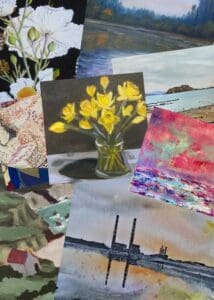The Importance of Taking Breaks: Rest as a Tool for Creativity
In the fast-paced world of art, it’s easy for artists to fall into the trap of continuous work. The pressure to produce can be overwhelming, leading many to believe that constant creation is the key to success. However, what if I told you that stepping away from your easel, canvas, or sketchbook could be just as crucial—if not more so—for your artistic journey? In this blog post, we will explore the significance of taking intentional breaks and how these pauses can enhance creativity, foster fresh perspectives, and ultimately lead to a richer artistic practice.
Understanding the Creative Process
Before delving into the importance of breaks, it’s essential to understand the creative process itself. Creativity isn’t just about sitting down and producing work; it’s a complex cycle involving inspiration, ideation, execution, and reflection. According to psychologist Mihaly Csikszentmihalyi, who popularized the concept of “flow,” creativity often thrives in states of both immersion and relaxation.
When artists are continually immersed in their work without breaks, they may experience burnout, fatigue, and a lack of fresh ideas. This stagnation can lead to frustration and diminished artistic quality. Therefore, integrating breaks into your routine can help you cycle through the creative process more effectively, allowing your mind to reset and rejuvenate.
The Science Behind Taking Breaks
Research shows that taking breaks can significantly enhance cognitive function and creativity. A study published in the journal Psychological Science revealed that brief diversions from a task can lead to improvements in performance on creative tasks. This phenomenon occurs because breaks allow your brain to process information more efficiently and develop new connections between ideas.
Furthermore, the concept of “incubation” in creativity suggests that stepping away from a problem or project can lead to new insights. During periods of rest, the unconscious mind continues to work on the creative challenges, often leading to breakthroughs that would not occur during focused work sessions.
Types of Breaks and Their Benefits
There are various ways to take breaks, each offering different benefits. Here are some effective strategies:
1. Short Breaks
Taking short breaks throughout your work session, often referred to as the Pomodoro Technique (25 minutes of focused work followed by a 5-minute break), can prevent fatigue and keep your mind sharp. During these breaks, engage in activities that refresh your mind, such as stretching, walking, or even a quick meditation session.
2. Long Breaks
Longer breaks, such as a day off or a weekend getaway, can provide a more profound reset. Use this time to immerse yourself in nature, explore new environments, or simply relax. These experiences can expose you to new ideas, colors, and forms that can later influence your artwork.
3. Creative Breaks
Engaging in different creative activities can also serve as a break. Try your hand at a new medium, such as sculpture, pottery, or photography. This change of pace allows you to see art from a new perspective and can inspire fresh ideas when you return to your primary practice.
4. Mindfulness and Meditation
Incorporating mindfulness practices can enhance your ability to take breaks. Meditation helps clear your mind and can lead to a deeper understanding of your artistic intentions. Consider using guided meditation apps like Headspace or Insight Timer to explore mindfulness tailored for creativity.
Fresh Perspectives through Rest
Taking intentional breaks can lead to a shift in perspective. When you step away from your work, you give your brain the chance to look at your projects from a distance. This new viewpoint can reveal aspects of your work that you may have overlooked, allowing you to refine your artistic voice and vision.
For instance, after a break, you might notice areas in your painting that need more contrast or composition adjustments that were not evident before. Fresh eyes often lead to enhanced problem-solving abilities and a more refined approach to your art.
Real-Life Examples of Artists Who Embrace Breaks
Many renowned artists have credited their breakthroughs to the power of rest. Take, for instance, Pablo Picasso, who frequently took breaks from his work to travel and experience new cultures. His time away from the canvas often resulted in dramatic shifts in his style and technique, ultimately influencing the trajectory of modern art.
Another example is the American artist Georgia O’Keeffe, who often took time away from painting to explore nature. Her travels across the American Southwest inspired much of her work, demonstrating how external experiences can rejuvenate an artist’s creative spirit.
Practical Tips for Integrating Breaks into Your Routine
- Schedule Breaks: Just as you would schedule time for art-making, allocate specific times for breaks. Treat these breaks as essential components of your creative process.
- Limit Distractions: During breaks, try to disconnect from technology. Put away your phone and avoid social media to fully engage with your time off.
- Explore New Interests: Use your break time to pursue hobbies outside of art. Whether it’s cooking, reading, or gardening, these activities can stimulate different parts of your brain and inspire your artistic practice.
- Reflect on Your Work: Use breaks to reflect on your artistic goals. Consider keeping a journal to jot down thoughts and ideas that arise during your time away from the easel.
- Reconnect with Nature: Nature has a remarkable ability to rejuvenate the mind. Spend time outdoors, whether it’s a walk in the park or a hike in the mountains, to clear your mind and gain inspiration.
The Long-Term Benefits of Taking Breaks
The long-term benefits of incorporating breaks into your artistic practice are profound. Regularly stepping away from your work can lead to improved mental health, reduced anxiety, and increased overall happiness. This holistic approach to creativity not only enhances the quality of your art but also fosters a deeper connection to your practice.
As you embrace the idea of taking breaks, you may find that your art becomes more authentic and reflective of your experiences. The time spent away can lead to a more fulfilling artistic journey and a deeper understanding of your creative self.
Conclusion
In conclusion, the importance of taking breaks cannot be overstated in the world of art. Intentional rest serves as a powerful tool for enhancing creativity, providing fresh perspectives, and rejuvenating the artistic spirit. By integrating breaks into your routine, you’ll not only improve your work but also foster a more balanced and fulfilling artistic life.
Embrace the power of rest, and you may discover that your next masterpiece is just a break away.
External Resources
- Psychological Science Study on Breaks and Creativity
- Mihaly Csikszentmihalyi’s Work on Flow
- Headspace
- Insight Timer
By focusing on the importance of taking breaks, artists can cultivate a more sustainable and enriching practice. Embrace the pause, and watch your creativity flourish!
*For collaborations, art features, or inquiries, please contact us at [email protected]. Don’t forget to follow us on Instagram, Facebook, Twitter.
Disclaimer: The views and opinions expressed in this article do not necessarily reflect the official policy or position of Irish Artmart.
Irish Artmart – Your Gateway to Artistic Excellence.
Tips to Express Your Creative Vision – Irish Artmart Podcast




